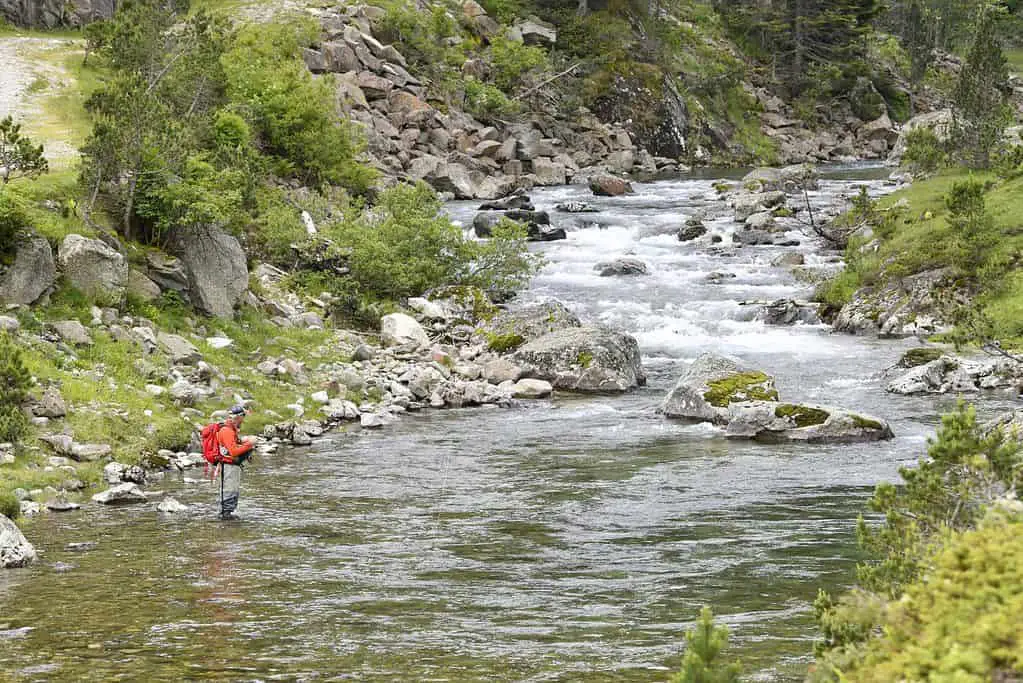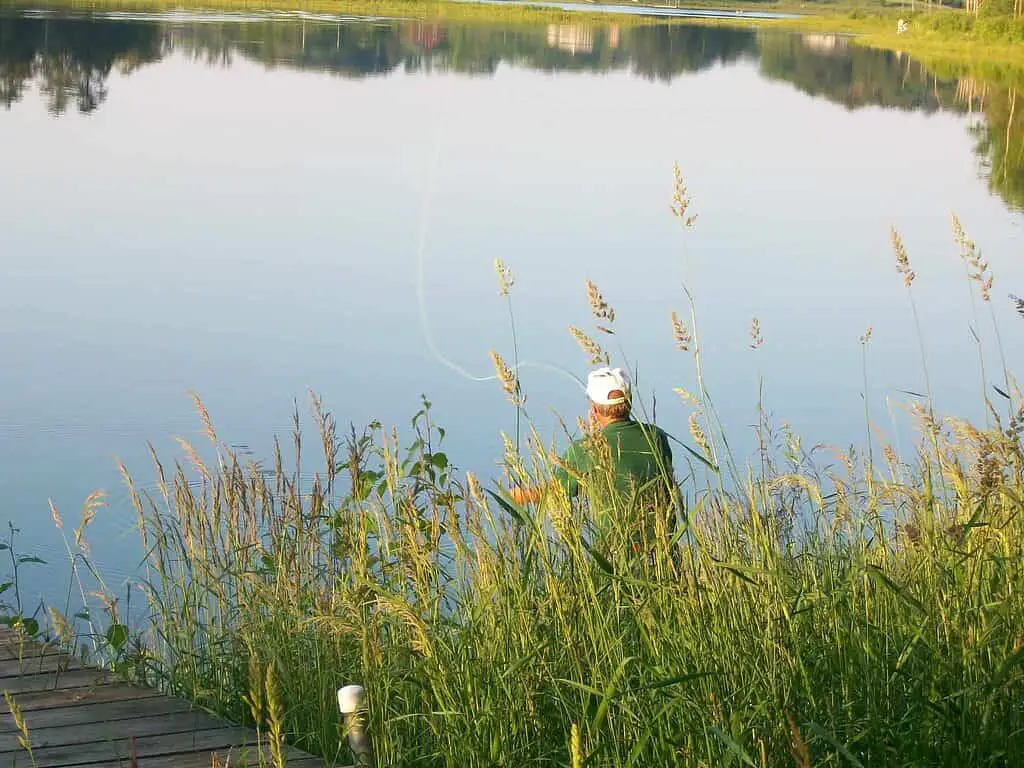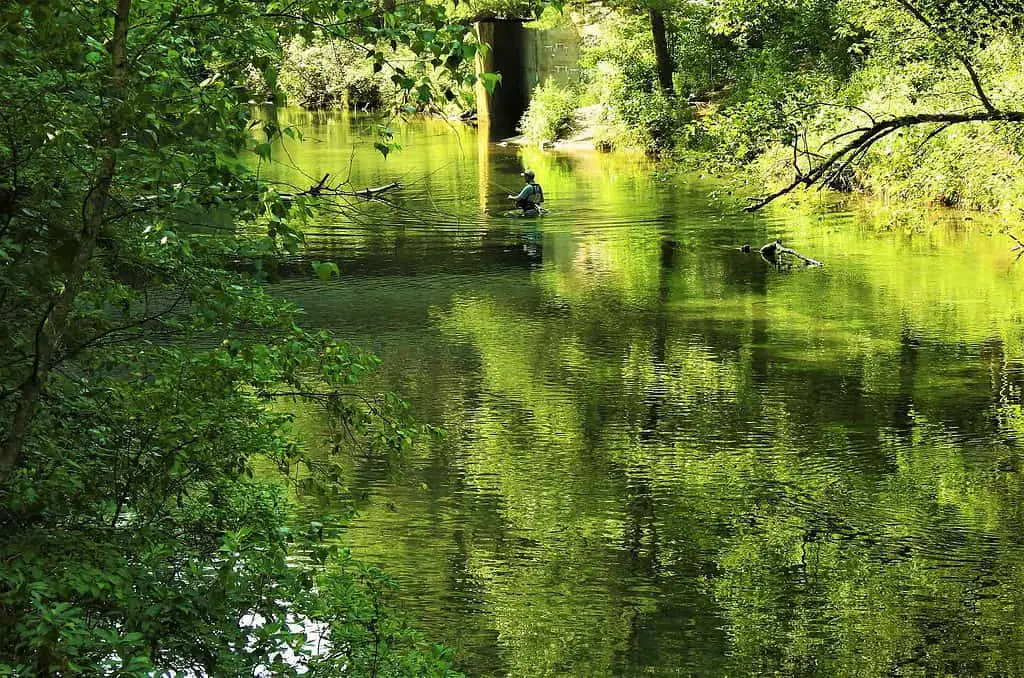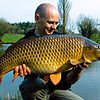Disclosure: Some posts contain affiliate links, which earn us a commission if you make a purchase through them. Positive Fishing © participates in various affiliate networks including the Amazon Services LLC Associates Program.
An angler’s first time fishing for trout is more often than not going to be a massive learning experience. Trout are finicky fish that can avoid a certain bait one day and completely demolish it the next. Thankfully, once you learn a couple of methods that work you should never find yourself skunked.
Trout are beautiful fish and often live in amazing parts of the world. Enjoy the scenery as you target them. Be patient and be willing to learn! The hard work will definitely be well worth the effort.
In this article, I will cover:
- Where are the Best Places to Find Trout?
- How to Fish for Trout in Lakes? – Stillwater
- How to Fish for Trout in Rivers and Streams? – Moving Water
- What Bait and Tackle are Needed for Trout Fishing?
- Top Tips for Catching and Landing More Trout
Where are the Best Places to Find Trout?

When you’re looking to target trout, there are a few critical characteristics the water must have. They’re fairly fragile fish and if one of these things is missing, the water may not be suitable for trout.
Best Temperature For Trout Fishing?
First, the water should be clear and cold. Ideally, the water you’re fishing in is somewhere in the neighborhood of 45 to 65 degrees. These temperatures can sustain trout, but also keep them quite active. Anything colder or warmer than this water is going to make them extremely sluggish and may cause these fish to die.
A moderately cool temperature body of water like this is likely found in higher elevations or below a dam. Tailwaters and high rivers, lakes, and streams are going to be ideal for trout! Check with your local Game and Fish Department before you purchase all the equipment for trout! Make sure there’s a nice population that’s able to sustain itself.
What Food Are Trout Looking For?
Like any other living organism, trout are going to need something to eat. If you’ve spent any time in the mountains near bodies of water, you’ll notice that in the mornings and evenings there are quite a few ripples on the surface. These are more than likely trout feeding on the insects that are hatching near the surface.
Mayflies, Caddisflies, and other sorts of aquatic insects are a favorite for trout. They feed on insects in their larvae stages to the time they become an adult. The mornings and evenings are when the hatch happens! When insects are flying above the water, it’s time to start targeting these fish on the surface.
Also, natural living things inside the water such as crayfish, minnows, and leeches are favorites for trout!
You can read more information on the best natural baits for trout here!
Do Trout Like Cover?
Yes, trout will always prefer to stay near cover. Since the water trout live in is often cool due to the temperature, it makes these fish more susceptible to predators. Make sure you are fishing around those cut banks, logs, and rocks that allow fish to hide in the middle of the day. If they can’t hide, the population will not last!
How to Fish for Trout in Lakes? – Stillwater

and using your eyes to search for roaming trout
When you’re lake fishing for trout, you always have the potential to catch a trophy. Lakes are generally deeper and have a decent amount of food and structure. Both of these things lead to some extremely large fish!
Understand Trout Movements
In lakes, trout are often moving around in search of food. However, there’s always going to be cover close so they can hide in case they find any sort of predator in the area. They are known to be ambush predators so a quick dart away from cover to snag a minnow or a crayfish. Mornings and evenings are prime feeding times for trout.
Focus on Cover For Trout When Fishing Lakes
If you’re limited to fishing from shore, make sure you aren’t only casting out into the middle of the lake or pond and expecting to land fish. On lakes, the cover areas are more important to find. Any place that looks like a safe haven for fish is likely where you’re going to find some.
Also, if you are able to fish near a creek that runs into the lake, that’s going to be a common spot for fish. The fresh water and food sweeping into the lake are a favorite for large fish. They don’t have to work exceptionally hard, but still get their fill. Plus, there’s usually a fair share of trees or rocks at the mouth of these.
Best Depth For Trout Fishing?
The final thing to focus on is how deep you’re fishing. The warmer the temperature, the deeper you’re going to want to fish. Trout hate being warm for an extended time, so on those warm summer days, you’re going to have to get to the deep water to coax them from their hiding places.
If it’s a cold day, it’s not uncommon to find trout sunning themselves in some shallower water. When they’re sunning themselves, they’re extremely easy to spook. Their senses are on high alert so make sure you’re presenting the bait as stealthily as possible.
How To Fish for Trout in Rivers and Streams? – Moving Water

Targeting trout in moving water is the way these fish are meant to be pursued! It’s a level playing field that requires proficiency from anglers and some luck on your side. Thankfully, in most rivers or streams trout will behave similarly. Fish streams and rivers after the runoff in the spring, throughout the cooler parts of the summer, and into the fall. The winter can be productive too if you’re patient.
Fishing In Pools, Pools, Pools
There’s a reason you’ll see a couple of anglers fishing one pool in a river. Trout don’t always want to be fighting the current, they want to preserve as much energy as possible. They’d rather dart into the fast-moving current, snag their food and get back to slack water.
As a result, pools are going to hold fish. They always have and always will. Now, don’t just cast into the middle of a pool and expect to find fish. Cast into the riffles before the pool and let your bait drift naturally down to the trout. Don’t rush this process. Fish will find your bait!
If you’re fishing the back of the pool, cast more towards the middle or the bank and let it drift towards the back. Fish will sometimes sit at the back to make sure no food escapes without having a chance to grab it.
Fish Bends in the River
Bends in the river or “eddies” are another common spot for trout to sit. These eddies are usually quite deep and make for an easy place for trout to sit. Imagine that trout are waiting for food to come to them instead of searching for it themselves.
Cast your bait right before the river starts to bend and wait for your bait to drift into the slower-moving water. You’ll be shocked at how fast a fish picks up your bait.
Fish Pocket Water
In the world of fly fishing, anglers are very familiar with pocket water. Pocket water is the slack water behind rocks or logs in faster currents. It may look too fast for you, but you’ll be shocked at the size of fish you can pull out from these small sections of slower-moving water. Big fish like to sit here because they don’t have to compete as much with the smaller fish.
Cast upstream from the pocket and let the current suck your bait down into that small portion of slow water. Wait for one or two seconds for it to swirl and you’ll likely have a bite. It’s smart to work your way through as many pockets as you can find. It’s not extremely challenging fishing, but it’s always productive. You’ll always be able to pull a couple of fish out of these areas in the river or stream.
What Bait and Tackle Are Needed for Trout Fishing?
Since there are so many different ways to target trout, you have about as many options as you would like. The first thing you need to decide is how you want to target these fish! Your two primary options are fly fishing and spin fishing.
Fly Fishing
If you’re fly fishing, you’ll want to purchase somewhere between a 4 and a 6-weight rod. An ideal length for these fly rods is around 8 or 9 feet. Make sure your reel is the same weight or one weight heavier than your rod. This will ensure the balance is exactly where it needs to be.
Your fly line should be a floating line that is the same weight as your rod and reel!
For flies, you’ll want a mixture of streamers, nymphs, and dry fly patterns. Some great streamers are Woolly Buggers, Deceivers, Clouser Minnows, and Galloup’s Sex Dungeons. For nymphs, make sure you have your fair share of Pheasant Tails, Prince Nymphs and Midge Nymphs. These are successful all over the world.
For dry fly fishing, Caddisflies, Parachute Adams, Chubby Chernobyl’s, and any sort of Mayfly pattern are going to help you land fish.
Check out my links to read more detailed information on Fly Fishing Flies and fly fishing basics with an emphasis on getting started for beginners.
Spin Fishing
For those interested in spin fishing, a 6 or 7-foot casting rod with 4 to 6-pound monofilament should do the trick. A bit more lightweight rod is going to help you catch the softer strikes and finesse your way through tighter conditions.
Also, make sure you have some Mepps Spinners and Panther Martins lures. If you don’t want to go the spinner route, a bobber, size 8 hook, Berkley Powerbait, and split shots will give you a great opportunity to land fish.
Check out my links to read more on Spin Fishing lures, and how to spin fish fast-moving water here!
Top Tips for Catching and Landing More Trout
First, you always want to make sure you’re targeting trout at the proper depth. They feed on the bottom, the center of the water column, and the surface. The closer to the hatch, the closer to the surface trout will feed. This takes some trial and error to learn, but the proper depth is necessary!
The time of day does matter when going after trout. Trout are always far more active in the mornings and evenings. Yes, they’ll hit in the middle of the day, but make sure you’re on the water for some portion of primetime.
Stay by structure and you’ll always have a chance at landing one of these fish. The more open water you fish, the less chance you have of catching a trout. They have a strong desire to be safe!
Final Thoughts
Trout are beautiful and can fight surprisingly well. Since they’re so temperamental, you’re going to have to spend some time learning their tendencies. It’s the right of passage every trout angler has.
Don’t get overly frustrated if you’re not successful the first time. Their elusiveness is what makes them so fun to target!
I hope this post has inspired you to try trout fishing. You can read more of my articles on live and natural baits for trout and where are the best places to fish for trout in the USA.
- Wading Belt Essentials: Ensuring Safer Fishing - January 9, 2024
- Fishing For Catfish (Top Tips, Bait, & Gear To Catch The Big 3) - October 20, 2022
- Fishing Line Strength Vs. Diameter Chart: Why Is It Important? - October 12, 2022

